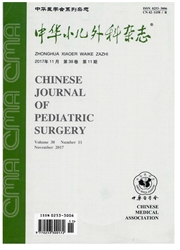

 中文摘要:
中文摘要:
目的 比较氟他胺(flutamide,Flu)、邻苯二甲酸二丁酯(dibutyl phthalate,DBP)、己烯雌酚(diethylstilbestrol,DES)诱导建立隐睾大鼠模型的病理表现,选择适宜研究隐睾生殖母细胞发育缺陷的动物模型.方法 SD孕鼠于妊娠12~21 d分别给予Flu(25 mg·kg-1·d-1)、DES(1.5μg·kg-1·d-1)皮下注射,DBP(500 mg·kg-1·d-1)灌胃建立隐睾模型,设立空白无干预组及玉米油皮下注射组为对照组,共5组.出生后(postnatal day,PD)20、80天获取睾丸组织,比较各药物诱导后隐睾发生率、睾丸形态学、组织学的差异.结果 Flu及DBP诱导隐睾睾丸体积PD20分别为(123.27±7.09)mm3、(117.39±8.00)mm3,PD80为(0.96±0.26)cm3、(0.79±0.28)cm3.隐睾睾丸脏器系数PD20分别为(2.27±0.09)‰、(2.26±0.09)‰,PD80分别为(1.94±0.62)‰、(2.20±0.87)‰.隐睾平均曲细精管直径(MSTD)PD20分别为(91.50±6.29)μm、(94.74±6.75)μm,PD80分别为(161.26±33.80)μm、(122.20±12.55)μm.隐睾平均曲细精管面积(MSTA)PD20分别为(6.62±0.90)×103μm2、(7.14±1.03)×103μm2,PD80分别为(2.00±1.00)×104μm2、(1.19±0.24)×104μm2.隐睾体积、脏器系数、MSTD及MSTA较对照组有明显差异(P<0.01).Flu诱导隐睾管腔化延迟,PD20、PD80管腔中央仍可见生殖母细胞(Gonocyte,Go)残留.DES未诱导出SD大鼠隐睾,DBP组睾丸均无Go残留.结论 Flu诱导的隐睾组织中存在Go迁移障碍,曲细精管发育延迟,该模型更适宜于研究临床隐睾Go发育障碍.
 英文摘要:
英文摘要:
Objective To establish the rat model of cryptorchidism induced by fetal drug exposure. Methods Pregnant SD rats were randomly assigned into 5 groups according the treatment.From the gestational day 12 to day 21, the rats of the DBP group were administered with dibutyl phthalate (DBP, 500 mg·kg^-1·d^-1) by gastric gavage. The rats of the Flu and Des group were injected subcutaneously with flutamide (Flu, 25 mg·kg^- 1 ·d ^-1) and dibutyl phthalate (DBP, 1.5μg·kg^-1 · d^-1) and diethylstilbestrol (DES), respectively. The normal pregnant rats were injected subeutaneously with corn oil ( 1ml · kg^-1· d^-1 ). The pregnant rats without any treatment were taken as blank controls.The testes were removed on postnatal day 20 and day 80 (PD20 and PD80). The incidence of cryptorchidism was recorded. The testes' morphology and histology were also studied. Results The fetal DES exposure failed to induce cryptorchidism. Of the Flu rats on PD20 and PD80, testis volumes were ( 123. 27 ± 7. 09)mm3 , and (0. 96 ± 0. 26)cm3 , respectively. The organ coefficients were (2. 27 ±0. 09)‰, and ( 1.94 ± 0. 62)‰, respectively. Mean seminiferous tubule diameters (MSTD) were (91.50 ± 6. 29)μm and ( 161.26 ± 33. 80)μm, respectively. Mean seminiferous tubule areas (MSTA)were (6. 62 ± 0. 90 ) × 10^3 μm^2 and (2. 00 ± 1.00) × 10^4μm^2 and ( 1.19±0. 24) × 10^4 μm^2 , respectively. Of the DBP rats on PD20 and PD80, testis volumes were (117. 39 ±8. 00)mm^3 , and (0. 79 ± 0. 28) cm^3, respectively. The organ coefficients were (2. 26± 0. 09)‰, and (2. 20± 0. 87)‰, respectively. Mean seminiferous tubule diameters (MSTD) were (94. 74± 6. 75)μm, and (122. 20± 12. 55)μm, respectively. Mean seminiferous tubule areas (MSTA) were (7. 14 ± 1.03) ×10^3 μm^2, and (1.19 ±0. 24) × 10^4 μm^2 , respectively. The testis volumes, organ coefficient, MSTD and MSTA of the Flu and DBP rats on PD20 and PD80 were sign
 同期刊论文项目
同期刊论文项目
 同项目期刊论文
同项目期刊论文
 期刊信息
期刊信息
